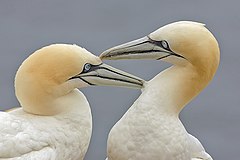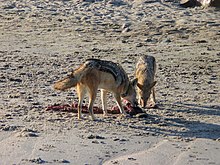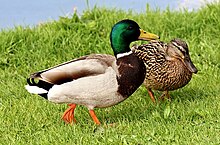Pair bond

Inbiology,apair bondis the strong affinity that develops in somespeciesbetween a mating pair, often leading to the production and rearing of young and potentially a lifelong bond. Pair-bonding is a term coined in the 1940s[1]that is frequently used insociobiologyandevolutionary biologycircles. The term often implies either a lifelongsocially monogamousrelationship or a stage of mating interaction in socially monogamous species. It is sometimes used in reference to human relationships.
Varieties
[edit]
According to evolutionary psychologistsDavid P. Barashand Judith Lipton, from their 2001 bookThe Myth of Monogamy,there are several varieties of pair bonds:[2]
- Short-term pair-bond:a transient mating or associations
- Long-term pair-bond:bonded for a significant portion of the life cycle of that pair
- Lifelong pair-bond:mated for life
- Social pair-bond:attachments for territorial or social reasons
- Clandestine pair-bond:quickextra-pair copulations
- Dynamic pair-bond:e.g.gibbonmating systems being analogous to "divorce"
Examples
[edit]Birds
[edit]Close to ninety percent[3]of known avian species aremonogamous,compared to five percent of known mammalian species. The majority of monogamous avians form long-term pair bonds which typically result in seasonal mating: these species breed with a single partner, raise their young, and then pair up with a new mate to repeat the cycle during the next season. Some avians such asswans,bald eagles,California condors,and theAtlantic Puffinare not only monogamous, but also form lifelong pair bonds.[4]
When discussing the social life of thebank swallow,Lipton and Barash state:[2]
For about four days immediately prior to egg-laying, when copulations lead to fertilization, the male bank swallow is very busy, attentively guarding his female. Before this time, as well as after—that is, when her eggs are not ripe, and again after his genes are safely tucked away inside the shells—he goes seeking extra-pair copulations with the mates of other males…who, of course, are busy with defensive mate-guarding of their own.

In various species, males provide parental care and females mate with multiple males. For example, recent studies show that extra-pair copulation frequently occurs in monogamous birds in which a "social" father provides intensive care for its "social" offspring.[5]Furthermore, it was observed that newly formed pair bonds in biparental plovers were comparatively weaker than those in uniparental plovers.[6]
Fish
[edit]AUniversity of Floridascientist reports that male sandgobieswork harder at building nests and taking care of eggs when females are present – the first time such "courtship parental care" has been documented in any species.[7]
In the cichlid speciesTropheus moorii,a male and female will form a temporary monogamous pair bond and spawn; after which, the female leaves tomouthbroodthe eggs on her own.T. mooriibroods exhibitgenetic monogamy(all eggs in a brood are fertilized by a single male).[8]Another mouth brooding cichlid – the Lake Tanganyika cichlid (Xenotilapia rotundiventralis) has been shown that mating pairs maintain pair bonds at least until the shift of young from female to male.[9]More recently the AustralianMurray codhas been seen maintaining pair bonds over 3 years.[10]
Pair bonding may also have non-reproductive benefits, such as assisted resource defense.[11]Recent study comparing two species of butterflyfishes,C. baronessaandC. lunulatus,indicate increase in food and energy reserves compared to individual fish.[12]
Mammals
[edit]Monogamousvoles(such as prairie voles) have significantly greater density and distribution ofvasopressinreceptors in their brain when compared to polygamous voles. These differences are located in the ventral forebrain and the dopamine-mediatedreward pathway.
Peptide argininevasopressin(AVP),dopamine,andoxytocinact in this region to coordinate rewarding activities such as mating, and regulate selective affiliation. These species-specific differences have shown to correlate with social behaviors, and in monogamous prairie voles are important for facilitation of pair bonding. When compared tomontane voles,which arepolygamous,monogamousprairie volesappear to have more of these AVP and oxytocinneurotransmitter receptors.It is important that these receptors are in the reward centers of the brain because that could lead to aconditionedpartner preference in the prairie vole compared to the montane vole which would explain why the prairie vole forms pair bonds and the montane vole does not.[3][13]
As noted above, different species of voles vary in their sexual behavior, and these differences correlate with expression levels of vasopressin receptors in reward areas of the brain. Scientists were able to change adult male montane voles' behavior to resemble that of monogamous prairie voles in experiments in which vasopressin receptors were introduced into the brain of male montane voles.[citation needed]
Humans
[edit]
Humans can experience all of the above-mentioned varieties of pair bonds. These bonds can be temporary or last a lifetime.[14]They also engage in social pair bonding, where two form a close relationship that does not involve sex.[15]Like in othervertebrates,pair bonds are created by a combination of social interaction and biological factors includingneurotransmitterslikeoxytocin,vasopressin,anddopamine.[15][16]
Pair bonds are a biological phenomenon and are not equivalent to the human social institution ofmarriage.Married couples are not necessarily pair bonded. Marriage may be a consequence of pair bonding and vice versa. One of the functions of romantic love is pair bonding.[17][15]
See also
[edit]- Affectional bond
- Attachment theory
- Animal sexuality
- Breeding pair
- Human bonding
- r/K selection theory
References
[edit]- ^"Pair-bond".Home: Oxford English Dictionary.Oxford English Dictionary.2005.
- ^abBarash D, Lipton J (2001).The Myth of Monogamy: Fidelity and Infidelity in Animals and People.New York: Henry Holt and Company.ISBN978-0805071368.
- ^abYoung LJ (2003)."The Neural Basis of Pair Bonding in a Monogamous Species: A Model for Understanding the Biological Basis of Human Behavior".In Wachter KW, Bulatao RA (eds.).Offspring: Human Fertility Behavior in Biodemographic Perspective.Washington (DC): National Academies Press (US).ISBN978-0-309-08718-6.Archivedfrom the original on 6 February 2018.Retrieved11 June2018– via www.ncbi.nlm.nih.gov.
- ^Berger M (10 February 2012)."Till Death do them Part: 8 Birds that Mate for Life".National Audubon Society.Retrieved11 June2018.
- ^Wakano JY, Ihara Y (August 2005). "Evolution of male parental care and female multiple mating: game-theoretical and two-locus diploid models".The American Naturalist.166(2): E32–44.doi:10.1086/431252.PMID16032569.S2CID23771617.;Lay summary in:"New Study Explores The Evolution Of Male Parental Care And Female Multiple Mating".ScienceDaily.Archivedfrom the original on 2015-09-05.
- ^Parra, Jorge E.; Beltrán, Marcela; Zefania, Sama; Dos Remedios, Natalie; Székely, Tamás (2014-04-01)."Experimental assessment of mating opportunities in three shorebird species"(PDF).Animal Behaviour.90:83–90.doi:10.1016/j.anbehav.2013.12.030.ISSN0003-3472.S2CID15727544.
- ^Pampoulie C, Lindström K, St Mary CM (March 2004)."Have your cake and eat it too: male sand gobies show more parental care in the presence of female partners".Behavioral Ecology.15(2): 199–204.doi:10.1093/beheco/arg107.;Lay summary in:"For A Male Sand Goby, Playing 'Mr. Mom' Is Key To Female's Heart".ScienceDaily.Archivedfrom the original on 2016-03-05.
- ^Steinwender B, Koblmüller S, Sefc KM (February 2012)."Concordant female mate preferences in the cichlid fishTropheus moorii".Hydrobiologia.682(1): 121–130.doi:10.1007/s10750-011-0766-5.PMC3841713.PMID24293682.
- ^Takahashi T, Ochi H, Kohda M, Hori M (June 2012)."Invisible pair bonds detected by molecular analyses".Biology Letters.8(3): 355–357.doi:10.1098/rsbl.2011.1006.PMC3367736.PMID22114323.
- ^Couch AJ, Dyer F, Lintermans M (2020)."Multi-year pair-bonding in Murray cod (Maccullochella peelii) ".PeerJ.8:e10460.doi:10.7717/peerj.10460.PMC7733648.PMID33354425.
- ^Bales KL, Ardekani CS, Baxter A, Karaskiewicz CL, Kuske JX, Lau AR, et al. (November 2021)."What is a pair bond?".Hormones and Behavior.136:105062.doi:10.1016/j.yhbeh.2021.105062.PMID34601430.S2CID238234968.
- ^Nowicki JP, Walker SP, Coker DJ, Hoey AS, Nicolet KJ, Pratchett MS (April 2018)."Pair bond endurance promotes cooperative food defense and inhibits conflict in coral reef butterflyfish".Scientific Reports.8(1): 6295.Bibcode:2018NatSR...8.6295N.doi:10.1038/s41598-018-24412-0.PMC5908845.PMID29674741.
- ^Lim MM, Wang Z, Olazábal DE, Ren X, Terwilliger EF, Young LJ (June 2004). "Enhanced partner preference in a promiscuous species by manipulating the expression of a single gene".Nature.429(6993): 754–757.Bibcode:2004Natur.429..754L.doi:10.1038/nature02539.PMID15201909.S2CID4340500.
- ^Overdorff DJ, Tecot SR (2006). "Social Pair-Bonding and Resource Defense in Wild Red-Bellied Lemurs (Eulemur rubriventer)".Lemurs.Developments in Primatology: Progress and Prospect. pp. 235–254.doi:10.1007/978-0-387-34586-4_11.ISBN978-0-387-34585-7.
- ^abcFuentes A (9 May 2012)."On Marriage and Pair Bonds".Psychology Today.Retrieved24 April2018.
- ^Garcia C (May 2019).The Role of Oxytocin on Social Behavior Associated with the Formation of a Social Pair-Bond in the Socially Monogamous Convict Cichlid (Amatitlania nigrofasciata)(PhD thesis). Winthrop University.
- ^Bode A, Kushnick G (2021)."Proximate and Ultimate Perspectives on Romantic Love".Frontiers in Psychology.12:573123.doi:10.3389/fpsyg.2021.573123.PMC8074860.PMID33912094.
